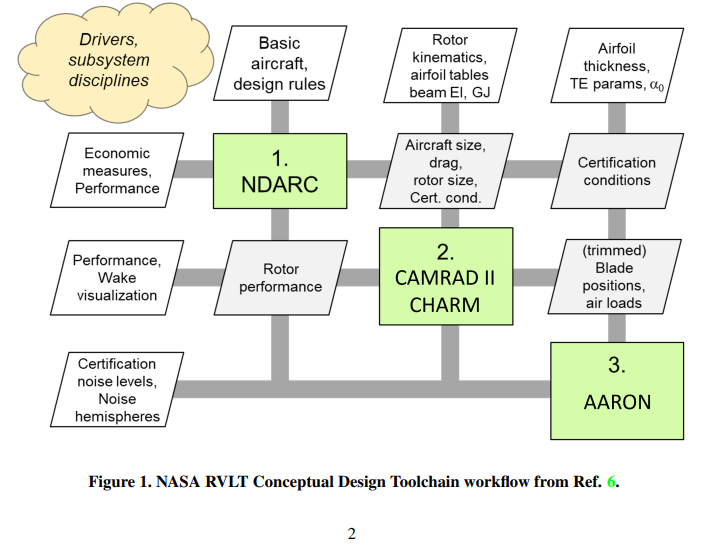How Much Noise Will a Single Rotor Make When a Single Rotor Makes Noise?
Use the NASA RVLT Conceptual Design Toolchain to Predict Best Practices

In their paper, “Best Practices for Predicting Acoustics of a Single Rotor Using the NASA RVLT Conceptual Design Toolchain” presented at the Vertical Flight Society’s 6th Decennial Aeromechanics Specialists’ Conference held in Santa Clara, California in February 2024, NASA aerospace engineers Lauren Weist, Natasha Schatzman, and Dorsa Shirazi detailed the results of their study intended to give conceptual designers the means and the tools necessary to accurately conduct noise prediction using the work done by NASA in developing revolutionary vertical lift technology (RVLT).
A New Toolchain to Quietly Take Flight
To continue its initiative to facilitate the development and implementation of an Urban Air Mobility (UAM) Market, researchers Weist, Schatzman, and Shirazi designed a suite of tools all rotorcraft designers reduce eVTOL rotor noise. The toolchain consists of following two steps: “comprehensive analysis and acoustic prediction.”
The study details best practices for using a pair of comprehensive analysis codes: CAMRAD II and CHARM and AARON, an acoustic code.
Developed by Dr. Wayne Johnson of Johnson Aeronautics, CAMRAD II (Comprehensive Analytical Model of Rotorcraft Aerodynamics and Dynamics) is an aeromechanical analysis of helicopters and rotorcraft that incorporates a combination of advanced technology, including multibody dynamics, nonlinear finite elements, structural dynamics, and rotorcraft aerodynamics.
Continuum Dynamics, Inc., developed the Complex Hazardous Air Release Model (CHARM) models rotor craft dynamic and aerodynamics, is mid-fidelity, and uses the constant vorticity contour method to model the aerodynamics for acoustic predictions. The work also incorporated the teachings gleaned from the Aircraft Noise Prediction Program’s (ANOPPs) Aeroacoustic ROtor Noise code (AARON).
Two single rotors were considered: “i) a simple rotor and ii) a rotor that is more representative of what UAM designers might use.” NASA’s best practices were presented to predict tonal and broadband self-noise, along with the corresponding results.
CONCLUSIONS
Best practices were developed for acoustic predictions using the acoustics code AARON with the comprehensive analysis codes CAMRAD II and CHARM as a part of the NASA RVLT Conceptual Design Toolchain. Two main rotors were shown: the Lopes rotor and the QSMR. The best practices summarized by NASA are as follows:
“1. Proper settings in both CAMRAD II and CHARM must be used to produce the outputs required by AARON to complete acoustic predictions.
2. Use the ‘reconstruction’ option in CHARM and the ‘post-trim’ option in CAMRAD II to produce adequate azimuthal resolution for accurately capturing high frequency acoustics. Additionally, use 50-100 aerodynamic panels in CHARM and 15-25 aerodynamic panels in CAMRAD II to obtain meaningful loading values. A panel study for the QSMR in forward flight with a free wake was conducted to verify the correct panel number settings.
3. Several variables are defined differently between CAM RAD II and CHARM and care must be taken to ensure correct modeling. The three settings considered in this section were: blade flapping, thrust coefficient, and number of revolutions.
4. When beginning to use either CAMRAD II or CHARM, it is important to begin with a simple rotor model and then increase complexity. For this work, a simple four bladed rotor called the ‘Lopes rotor’ was used for this initial step. Then, to increase complexity, the three-bladed 12 Figure 15. Total noise (thickness + loading) in CAMRAD II and CHARM using AARON for the QSMR in forward flight with a free wake model (Vin f =53.9 m/s, CT σ = 0.07, µ = 0.25, αs = -3◦ , θ0 = 4◦ ). Quiet Single Main Rotor was used. Additionally, it is recommended to begin with hover and a ‘simple wake’ uniform inflow before moving on to more complicated cases. The ‘simple wake’ forward flight total tonal noise results for both the Lopes rotor and the QSMR for a se lection of microphones were presented.
5. Both CAMRAD II and CHARM have different wake model options. This work recommends using increasing complexity to step through the wake models in order to ensure correct settings. The correct process of increasing wake complexity is simple wake to rigid wake to free wake
6. The Brooks-Pope-Marcolini model used in AARON required specific airfoil inputs as well as outputs from the comprehensive codes. A BPM parametric study was con ducted in order to identify and define these inputs and outputs to see their effect on broadband self-noise noise. Final broadband self-noise results for the Lopes rotor and QSMR with a free wake in forward flight were presented.
7. Metadata can be used to view plots of the internal calculations conducted by AARON. An example analysis of the vertical blade loading Fz for the QSMR in forward flight with a free wake for comparison between CAMRAD II and CHARM was shown.
8. The final free wake forward flight results for both the Lopes rotor and the QSMR for an array of 5 microphones were presented and discussed. For more simple rotors, good agreement between CAMRAD II and CHARM were found, while for more complex rotors, differences in the models leading to differences in loading noise were shown.”
In the future, NASA intends to extend these best practices to multirotor aircraft and ful vehicle models.
Subscribe to AeroCar Journal today. It’s free, for a limited time.
Dave Clarke
Dave Clarke is a California-based writer who is fascinated by the way technology changes our lives.


